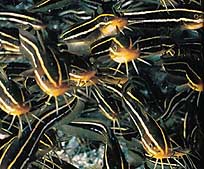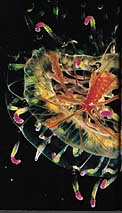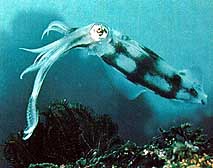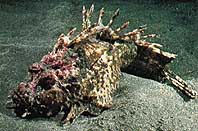In a unique system, Japan’s 160 national marine parks
(the largest number established by any country) are administered jointly by a
national park service and powerful local fishermen’s associations that
control access to the underwater preserves. Thus sport divers are forbidden to
spear a single fish within the parks, while commercial fishermen operate there
at will.
 A
school, or ‘catfish ball’ of poisonous Japanese catfish
A
school, or ‘catfish ball’ of poisonous Japanese catfish
Izu Oceanic Park, located south-west of Tokyo Bay, is
actually a commercial enclave within a larger national preserve that includes
Japan’s sacred Mount Fuji, the resort area of Hakone, most of the Izu
Peninsula itself, and seven nearby islands. The chilly waters are warmed by
the great Kuroshio (Black Stream), Japan’s equivalent of the Gulf Stream.
Swept by a mixture of temperate and tropical ocean currents, the great
undersea sanctuary abounds with a richness and variety of marine life rarely
found anywhere else in the world.
 Japan’s
‘cherry blossom’ jellyfish
Japan’s
‘cherry blossom’ jellyfish
In the twilight, Japanese fishing boats net thousands of
squid within the boundaries of the Park. Using powerful floodlights to attract
the delicacy known to the Japanese as ika, the boats employ sails which
are rigged astern to reduce the ship’s roll in the ocean swells.
Beneath a luminous canopy of surf, ghostly shapes of large
mullet glide among the submerged rocks. And those grim guardians of the
depths, the moray eels, lurk amid patches of brilliant orange soft coral 140
feet from the surface. Despite its ferocious appearance, and a length as great
as three feet, the Moray rarely attacks unless provoked. These eels often
cautiously emerge from their refuges when divers appear, look them over, and
retreat back into the darkness.
 Japan’s
ika squid, a delicacy in Japanese kitchens
Japan’s
ika squid, a delicacy in Japanese kitchens
There are, however, plenty of venomous catfish, the species
known as Plotosus lineatus, which assemble in tight formations referred
to as ‘catfish balls’. They carry a powerful poison in the spines of their
dorsal and pectoral fins. The poison (plototoxin) from just one fish can
seriously injure, and under some circumstances even kill, an unwary diver.
Fourteen different species of jellyfish inhabit the waters
of Izu, though none matches the kaleidoscope of the sea: the Olindias Formosa.
The creature’s brilliant colours earned it the Japanese name for ‘cherry
blossom’. Fuchsia-tipped tentacles resembling pipe cleaners radiate from the
jellyfish’s two inch wide bell. Each tentacle is equipped with hundreds of
stinging cells, which paralyses its victim.
Among the most deadly species in the ocean is the scorpion
fish. Unlovely and unloved, its face wears a perpetual frown, and it has few
friends. Bulbous glands on the 16 or 17 dorsal spines contain powerful venom.
These grotesque fish lie in wait for their prey under a mantle of sand.
The porcupine fish uses a nightmarish disguise and swells
with water, which frightens enemies as large as tiger sharks. But unlike most
blowfish in Japan, the Diodon is neither poisonous to touch nor to eat.
 The
stonefish - a killer
The
stonefish - a killer
Beneath the waters of the Izu, the ocean floor is a glowing
carpet of colour and variety. At least eight kinds of corals grow there,
including the treelike alcyconarian, a fan shaped gorgonian and the pinks and
saffrons of related species.
The giant spider crab of Japan dwarfs all the other
crustaceans, with a record span of 11 feet, between outstretched claws. Males
are distinguished from females not only by their size, but also by twin
penises shaped like corkscrews that extend beneath the abdomen. Largest of
Japan’s estimated one thousand crab species, the spiders reach adult size
within 10 years and may live half a century or more. Thanks to the poor
quality of its meat, the huge adult crab is caught more as a curiosity than
for food. The meat of the young crab, however, is excellent. Since crabs
require 10 years to reach mating age, many of the younger generation are
eliminated before they can reproduce. Most adults which are captured these
days are usually prized as tourist attractions. Several of these harmless
giants are on display at the Sunshine Aquarium in Tokyo.